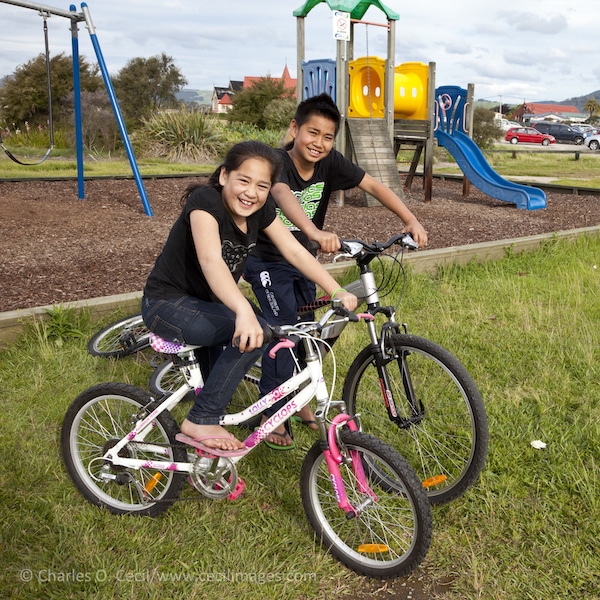
Maori Brother and Sister, Ohinemutu Maori Village, Rotorua, north island, New Zealand. Photo by Charles O. Cecil © chuck@cecilimages.com
By Charles Cecil
Many Western texts say Dutch East India Company explorer Abel Tasman discovered New Zealand in 1642. In fact, the islands’ first inhabitants were Polynesian Maori who arrived in successive waves 300 years before. Today the Maori comprise about 850,000 of New Zealand’s population of just over five million. About 86% live on the north island in places like Ohinemutu, a colorful neighborhood adjacent to the popular resort town of Rotorua.
On the day I arrived, children played happily on the swings beside Lake Rotorua from which clouds of steam languidly rose. Not far away, a black swan glided gently through another billowy wisp of moist, warm air. Was this a playground surrounded by a Turkish bath? If so, it didn’t seem to bother the children, happily engaged on the playground equipment.
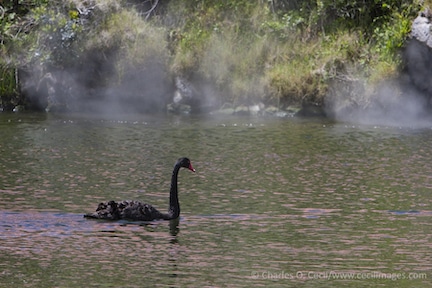
Ohinemutu Village, Lake Rotorua. Black Swan, Steam from Thermal Springs Rising in Background. Photo by Charles O. Cecil © chuck@cecilimages.com
Ohinemutu sits on the shores of Lake Rotorua below the crest of the hill that’s a short distance from the modern tourist facilities of Rotorua. Ohinemutu pre-dates all of Rotorua’s many restaurants and hotels and might escape your notice if you don’t make a small effort to find it. But its beautiful Maori meeting house, the attractive St. Faith’s Anglican Church and the numerous bubbling hot springs make a walk through this quaint and quiet neighborhood well worth a visit.
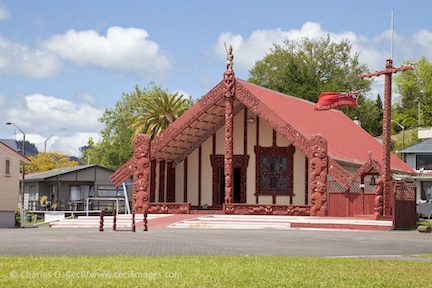
The Tama-Te-Kapua Meeting House of Ohinemutu. The figure at the top of the gable is Chief Tematekapua, captain of the canoe which arrived in New Zealand in 1350. Photo by Charles O. Cecil © chuck@cecilimages.com
The meeting house, or wharenui, is a natural magnet. Though closed to visitors, you can inspect its beautiful outside carvings up close. If you are lucky enough to find Shaloh Mitchell in his small tourist information office nearby, he may open the door for you and allow a look inside. Shaloh is the grandson of Hamuera Taiporutu Mitchell, former chief of all Maori living in the central part of New Zealand’s north island. The current wharenui, rebuilt in 1942-43, serves as the parliament building for representatives from all the northern Maori tribes who have been gathering in Ohinemutu for several centuries. It also is used as a meeting house for funerals and other community activities. Though fathers and sons may attend assemblies together, no son may speak in the meeting house until his father has passed away, or until the father has conferred on the son the right to speak.
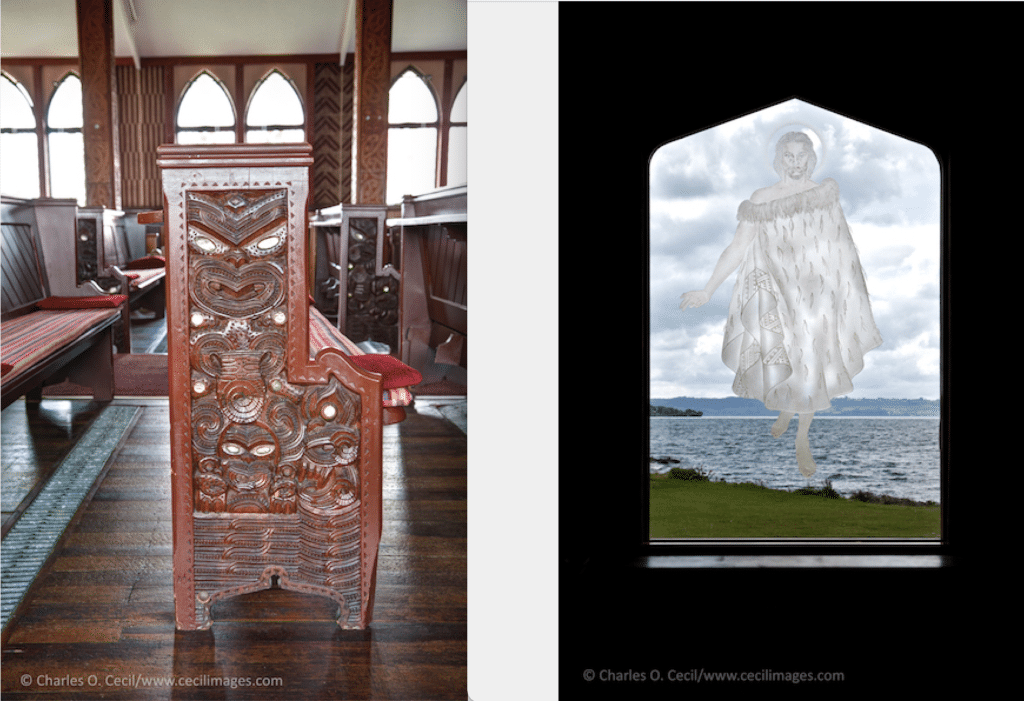 St. Faith’s Anglican church offers a wonderful example of the blending of two cultures, with pews carved in the Maori style. To the right of the altar is a window on which an image of Christ wearing a Maori cloak is engraved. If you sit or stand at just the right vantage point, Christ appears to be walking on the waters of Lake Rotorua, visible in the background through the window.
St. Faith’s Anglican church offers a wonderful example of the blending of two cultures, with pews carved in the Maori style. To the right of the altar is a window on which an image of Christ wearing a Maori cloak is engraved. If you sit or stand at just the right vantage point, Christ appears to be walking on the waters of Lake Rotorua, visible in the background through the window.
There is little traffic in Ohinemutu. Walking along the streets or down the neighborhood lanes, you’ll sense the gentle passing of years. Look closely and you’ll see boiling hot springs, many of which once were used by the Maori to cook their food.
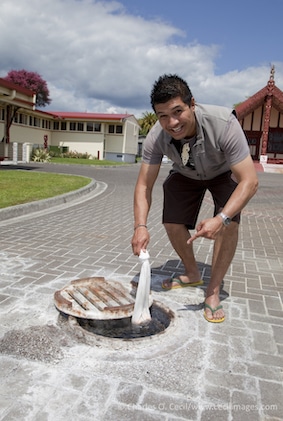
At the end of an hour-long walk around the village, Shaloh often offers his guests an ear of corn dipped for one minute in the boiling water that lies only inches below the paving stones. Photo by Charles O. Cecil © chuck@cecilimages.com
On a second visit I examined several long Maori canoes under construction on the lakeshore not far from the playground. As I walked back to my car parked near the playground, residents on a second-floor balcony invited me in for tea. Ohinemutu is that kind of a place—a quiet haven so near and yet so far from the bustle of Rotorua’s downtown. Here the friendship of neighbors still prevails – another dimension to an area more widely known for its geysers, mud-baths and other natural wonders.
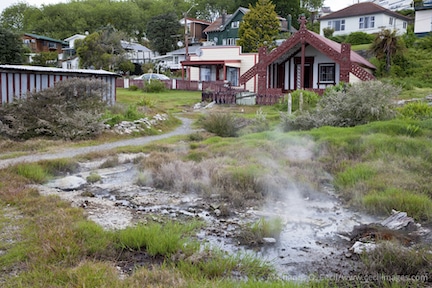
Thermal steam rises from the ground in front of local residences. Photo by © Charles O. Cecil, chuck@cecilimages.com
Rotorua began to develop as a tourist destination in the nineteenth century when the local Maori tribe began to attract visitors to the area’s thermal waters, believed to have healing powers. Designed in Tudor style, today’s Rotorua Museum of Art and History was built in 1908 as a spa to accommodate foreign visitors, including New Zealanders of Anglo origin. It was the New Zealand government’s first major investment in the tourism industry. The Bath House is a half-timbered building that has been called the most impressive Elizabethan Revival building in New Zealand.
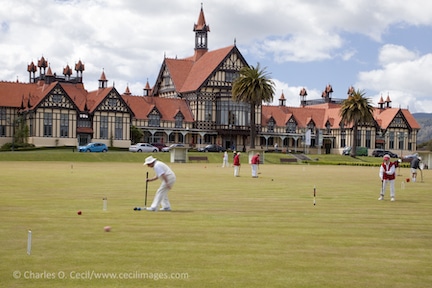
The Rotorua Museum of Art and History, built in Tudor style in 1908 to house thermal baths for tourists. Photo by Charles O. Cecil © chuck@cecilimages.com.
Unfortunately, the museum was closed in 2016 because it no longer met the country’s increasingly stringent earthquake standards. It will remain closed for the foreseeable future until a detailed earthquake assessment is made and remedial measures are completed. But its location in the Government Gardens of Rotorua still makes it an impressive sight.
Other geological features in the nearby Waiotapu (Maori for “sacred waters”) thermal area include sulfurous pools of various colors. The pools induce a calming effect and attract visitors to take a closer look, but beware. You do not want to turn into an ear of corn.

Left: The Oyster Pool, Waiotapu Thermal Area, a natural sulfurous pool. Right: The Devil’s Bath, Waiotapu Thermal Area. The color of the water is the result of water from the Champagne Pool mixing with sulfur and ferrous salts. The color changes from green to yellow depending on the amount of reflected light and the cloud cover. Photo by Charles O. Cecil © chuck@cecilimages.com
Today there are a number of Maori “villages” welcoming tourists interested in seeing aspects of Maori culture. This may include demonstrations of carving, weaving, tattooing, or sharing Maori food cooked in the traditional hangi style, cooked in a pit dug in the ground. Fish, sweet potatoes, pork, lamb, potato, pumpkin and cabbage wrapped in cloth sacks, aluminum foil and wire baskets may all be cooked in this way on hot stones covered with a wet cloth and a mound of dirt. Some villages welcome visitors with the traditional ‘Hongi’ greeting in which the Maori host presses his nose and forehead against the nose and forehead of the person being greeted.
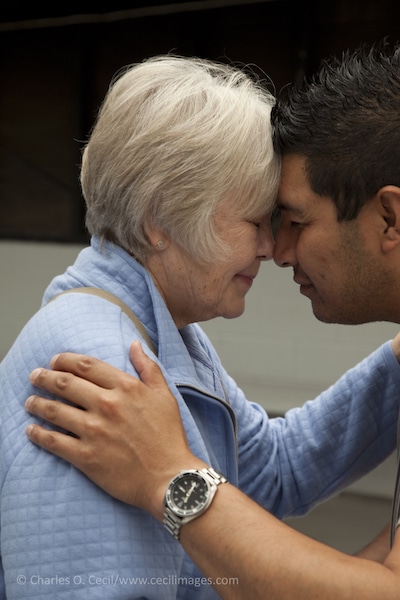
The popularity of the Rotorua area, only a three-hour drive south of Auckland (the usual arrival point for visitors coming by air), draws other events to the region. Nearby Blue Lake, a collapsed volcanic crater called Tikitapu, is a popular recreational venue. The lake is 27 meters deep and offers fishing, swimming, boating, water skiing, and jet skiing. It’s also a great place for a relaxing walk. Vendors nearby have bicycles for rent.
Once a year Tikitapu hosts the Blue Lake Triathlon, part of a larger Blue Lake Multisport Festival. The Triathlon is currently scheduled for January 29-30, 2022, though COVID restrictions could interfere. Most participants in these events are New Zealanders with some Aussies. Another annual event is the Xterra New Zealand Championships (currently April 9, 2022) consisting of a one-kilometer lake swim, a 32 km mountain bike ride, and an 11 km trail run. People can enter as individuals or in teams. Most of the events are off-road and attract lots of participants and spectators.
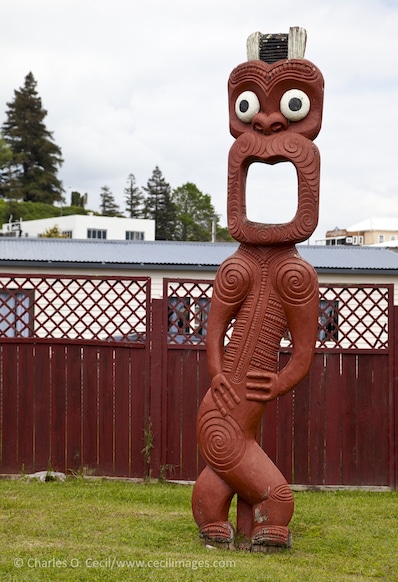
A Maori totem stands as a sentinel near the Ohinemutu Maori meeting house. Photo by Charles O. Cecil © Chuck@cecilimages.com
The compelling feature of Ohinemutu is that it’s not a tourist destination, but an authentic neighborhood where the Maori of Rotorua happen to live. It is a quiet area with nothing artificial created to attract foreign tourists. Most visitors will be unaware of its existence, but its church, meeting house, and the quiet residential streets with steam emerging here and there from the ground make it well worth a visit. New Zealand’s borders are currently closed to visitors from most countries, but optimists should start planning now for a 2022 trip.
After 36 years in the U.S. Foreign Service, Chuck Cecil became an international travel photographer and writer. His photos of daily life inside two northern India madrasas were honored by the American Society of Media Photographers in 2012. Awards from the Society of American Travel Writers followed for his images from Bali (2016), Bhutan (2019) and Singapore (2021).

